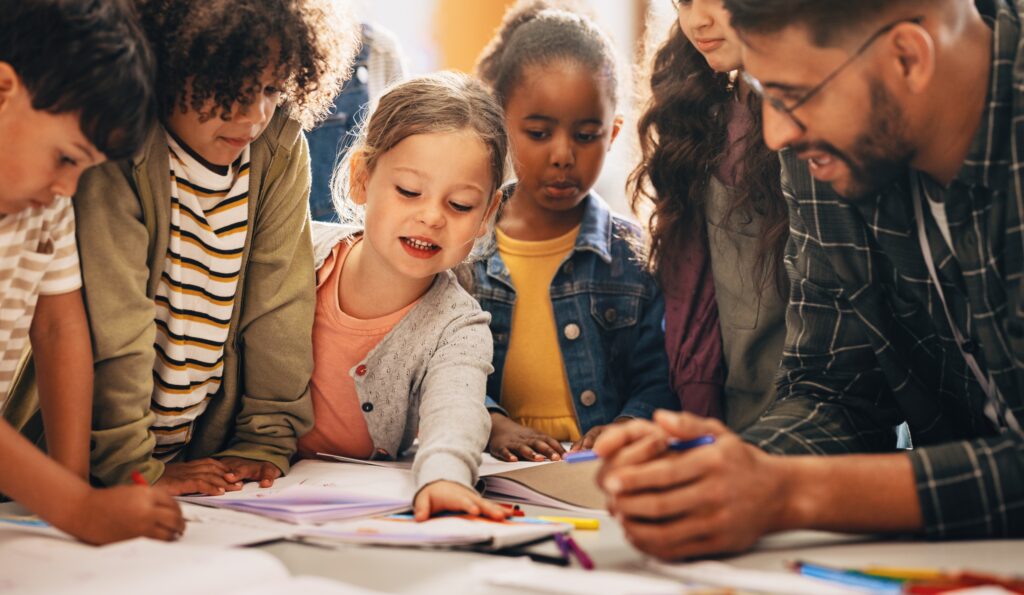
The Elementary Years: Energetic and Enthusiastic!—
You just can’t beat the hand-waving pride and enthusiasm of a 2nd grader who knows the answer and wants to be called on! Or the wide-eyed wonder of a 3rd grader when a new idea dawns on her for the first time. One morning we were reading the Acts 1 passage of Christ’s ascending into heaven, and when I read that the angel told the disciples Jesus would return, eight-year-old Austin was beside himself. “You mean He’s coming back??” If that doesn’t thrill your heart, I don’t know what will!
Considering the ages and stages of this group of children is crucial to having a vital and thriving elementary classroom. The chasm between a shy six-year-old little boy who is still an emerging reader and a confident “know-it-all” 4th grader can seem like the difference between a tadpole and a full-grown frog! Or should we say a cocoon and a butterfly! Regardless, if your church has these ages all together, the teacher needs to consider the characteristics of the younger children and the older children in this group.
Younger Children – 1st and 2nd graders:
- Think in literal, concrete terms
- Have difficulty sitting still
- Want to please the teacher
- Enjoy Bible stories
- Like to make things
- Tend to talk a lot
- Lack understanding of spiritual nature of God
Older Children – 3rd and 4th graders:
- Growing in ability to reason and discover
- Able to discuss ideas more in depth
- Enjoy physical activity and organized games
- Growing socially and emotionally
- Like frequent repetition of activities they enjoy
- Eager to learn and experiment
When planning the lesson and activities, think about the makeup of your particular class. Do you have more 1st and 2nd graders or more 3rd and 4th graders? If the class tends to be older, plan your lesson accordingly and perhaps pair the younger ones with an older “buddies.” If your class is on the young side, choose activities suited for them and assign your older kids to be “helpers,” maybe in listening to Bible verse or catechism recitations.
There are some ways to make the lesson come alive that will appeal to all the children in this mixed age group. For example, a stack of “gold” chargers brought in from your cupboard at home will work great for your class to be transformed into the 42,000 Israelites returning from captivity to Jerusalem bringing the gold and silver for the temple with them. A stuffed animal from your collection at home can double as the scapegoat in the book of Leviticus, as you take him “outside the camp.”
Both ages can memorize! What a great habit to instill in these minds at this age and stage! Of course, the younger kids will probably need shorter passages, but they can all do it. Stick with it. They all love prizes, games, and external motivators. And the 3rd and 4th graders can begin to develop the habit of reading the Bible at home on their own. GCP’s Middle Elementary curriculum provides weekly “Daily Soul Food” created with this in mind.
And…. You had better be ready for this group well BEFORE they come into the classroom! The cardinal rule in teaching elementary is to never have your back to the door as the children are entering. Be ready! Be prepared! Be waiting with energy, enthusiasm, and a smile!
Above all, point them to Jesus. In every class. In every lesson. In every interaction. Point them to the love of Christ. They will not remember all the details of the Bible stories you tell them. Pray that they will remember the love that Christ their Redeemer has for them.

Beth Myers has served as Curriculum Specialist at Great Commission for nearly 10 years. A job she truly enjoys! Her husband, Tom, is the pastor of First Presbyterian Church, Villa Rica, GA. They have 4 daughters and 14 grandchildren! Beth also enjoys volunteering at the local pregnancy center several nights a week.
